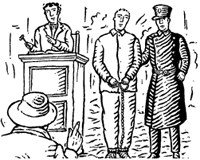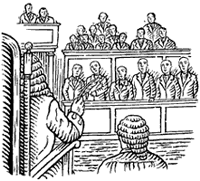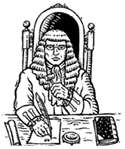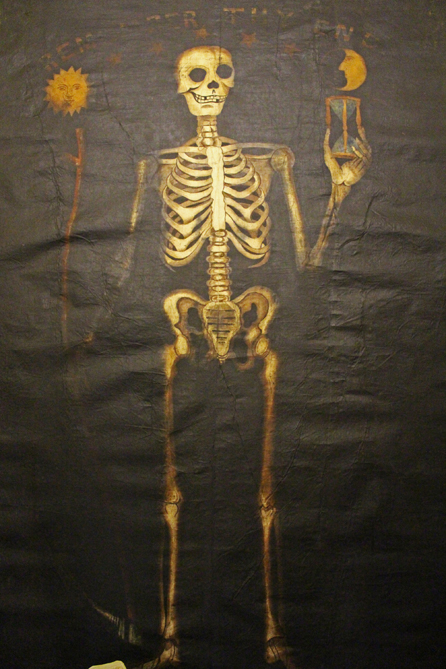 The Oath
The Oath
George Loveless and the union leaders needed to gather support from farm workers before they could confront the employers. To build the union they needed to win members and collect the pennies in subscriptions so they had more strength in numbers. To bind workers together in this common approach they used an oath of solidarity.
New members were asked to pledge their support to the society and their fellow workers with their hand on a bible and looking at a picture of a skeleton.
The oath was taken in the upstairs room of Thomas Standfield’s cottage in Tolpuddle.
The trumped-up charge
 Squire Frampton had been busily gathering evidence against the Tolpuddle men. There was already evidence from one of their fellow labourers, Edward Legg, who had betrayed them at a preliminary magistrate’s inquiry.
Squire Frampton had been busily gathering evidence against the Tolpuddle men. There was already evidence from one of their fellow labourers, Edward Legg, who had betrayed them at a preliminary magistrate’s inquiry.
Now Frampton wished Lord Melbourne to know that societies were being organised among the agricultural labourers, inducing them to enter into combinations of a dangerous and alarming kind to which they are bound by oaths administered clandestinely.
Melbourne advised caution. But once Frampton had proof of unlawful combination his lordship advised him to study section 25 of 57 Geo. III, c. 19, the Act of Parliament whose purpose was to more effectually prevent Seditious Meetings and Assemblies.
The rigged trial
 The Grand Jury’s foreman was William Ponsonby MP, brother-in-law to the Home Secretary Lord Melbourne. Members of the jury included James Frampton, his son Henry, his step-brother Charles Wollaston and several of the magistrates who had signed the arrest warrant.
The Grand Jury’s foreman was William Ponsonby MP, brother-in-law to the Home Secretary Lord Melbourne. Members of the jury included James Frampton, his son Henry, his step-brother Charles Wollaston and several of the magistrates who had signed the arrest warrant.
The trial was presided over by Judge Baron Williams whose closed mind was evident even before it properly began.
“The object of all legal punishment is not altogether with the view of operating on the offenders themselves, it is also for the sake of offering an example and a warning,” he declared.
The unjust sentence
 The landowner magistrates found a way of trapping and punishing the Martyrs, using two laws in combination.
The landowner magistrates found a way of trapping and punishing the Martyrs, using two laws in combination.
The men were tried at Dorchester Assizes in March 1834, found guilty of administering an unlawful oath, and sentenced to seven years’ transportation to Australia. The harshness and injustice of their treatment caused massive public outcry.
The Old Crown Court
For more on the court and how to visit click here.
 The Oath
The Oath